
Can a tiny territory in the South Pacific power Tesla's ambitions?
Because of its nickel industry, New Caledonia is one of the world's largest carbon emitters per capita and mining, which began soon after New Caledonia was colonised in 1853 is intimately linked to the exploitation of its Indigenous Kanak people
 A worker takes a sample of processed nickel at the Prony Resources nickel mine plant in Goro, New Caledonia, Nov. 24, 2021. Tesla wants to reinvent nickel mining, crucial to electric car batteries but a dirty and destructive process, by turning the Prony mine in New Caledonia into an experiment in sustainability. (Adam Dean/The New York Times)
A worker takes a sample of processed nickel at the Prony Resources nickel mine plant in Goro, New Caledonia, Nov. 24, 2021. Tesla wants to reinvent nickel mining, crucial to electric car batteries but a dirty and destructive process, by turning the Prony mine in New Caledonia into an experiment in sustainability. (Adam Dean/The New York Times)
GORO, New Caledonia — From the reef-fringed coast of New Caledonia, the Coral Sea stretches into the South Pacific. Slender native pines punctuate the shoreline. The landscape, one of the most biodiverse on the planet, is astonishingly beautiful until the crest of a hill where a different vista unfolds: a gouged red earth pierced by belching smokestacks and giant trucks rumbling across the lunarlike terrain.
This is Goro, the largest nickel mine on a tiny French territory suspended between Australia and Fiji that may hold up to one-quarter of the world’s nickel reserves. It also poses a critical test for Tesla, the world’s largest electric vehicle maker, which wants to take control of its supply chain and ensure that the minerals used for its car batteries are mined in an environmentally and socially responsible fashion.
Tesla’s strategy, the largest effort by a Western electric vehicle maker to directly source minerals, could serve as a model for a green industry confronting an uncomfortable paradox. While consumers are attracted to electric vehicles for their clean reputation, the process of harvesting essential ingredients like nickel is dirty, destructive and often politically fraught.
Because of its nickel industry, New Caledonia is one of the world’s largest carbon emitters per capita. And mining, which began soon after New Caledonia was colonized in 1853, is intimately linked to the exploitation of its Indigenous Kanak people. The legacy of more than a century of stolen land and crushed traditions has left Goro’s nickel output at the mercy of frequent labor strikes and political protests.
If done right, the approach by Tesla, which has the capacity to churn out close to 1 million cars a year, could lead the way in setting global standards for the electric vehicle revolution, in yet another convention-defying move by the company’s enigmatic founder, Elon Musk. It also provides Western car companies a path to begin sidestepping China, which currently dominates the production of electric vehicle batteries.
©2019 New York Times News Service







